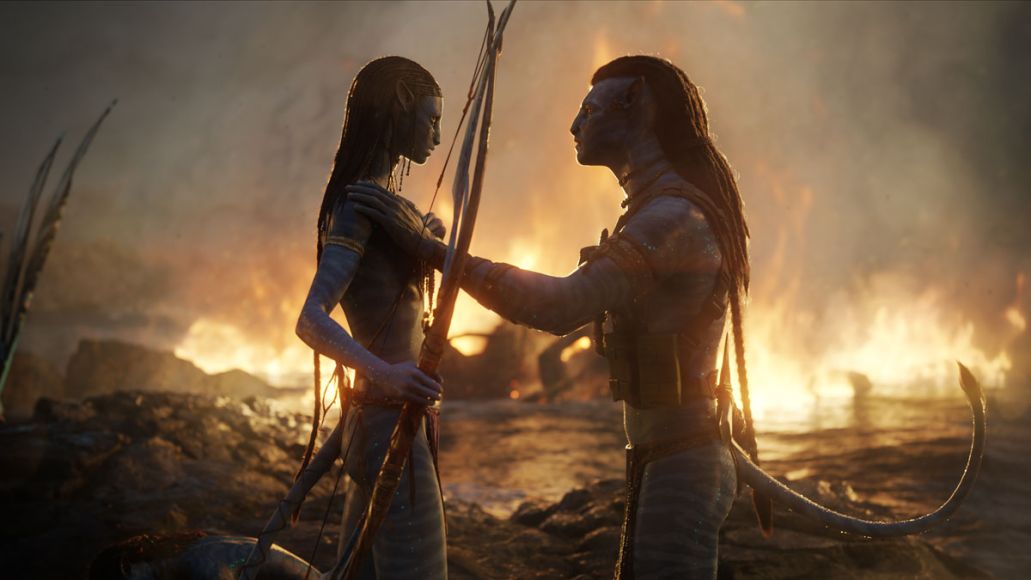The Pitch: If the phrase “we’re going back to Pandora!” is meaningless to you, or makes you think of a music streaming service, totally understandable. But y’all, we’re going back to Pandora, the Pandora in this case being the faraway planet at the center of James Cameron’s Avatar: The Way of Water, the very long-awaited sequel to the blockbuster director’s last major blockbuster.
Set over a decade after the original Avatar, The Way of Water goes through a relatively quick rundown of all the stuff that’s happened to human-turned-Na’vi Jake Sully (Sam Worthington), his Na’vi lover Neytiri (Zoe Saldana), and the others who stayed behind on Pandora since the human corporate interests retreated. The biggest thing? Jake and Neytiri have become parents, with three biological children and an adopted daughter named Kiri (played by Sigourney Weaver — we’ll get into it).
It’s a happy life for all involved — until, of course, humanity returns to Pandora to eff it all up. After a new corporate interest, led by General Frances Ardmore (Edie Falco, receiving one of the greatest character introductions of 2022), arrives to destroy yet more of Pandora’s beautiful ecosystem, Jake and Neytiri of course begin fighting back. So the humans bring in an old familiar foe, Miles Quaritch (Stephen Lang) — this time, in a cloned Na’vi body imprinted with his consciousness. Quaritch’s determined to hunt Jake and Neytiri down, and they choose to go into hiding to keep their family safe. But eventually, they have no choice but to return to the fight…
Let’s Talk About the Technology: All of the above is an accurate reflection of Avatar: The Way of Water’s basic premise. But the thing that is central to discussion of this film is how it looks. Until the recent re-release this fall, it was easy to forget that half of what made Avatar into a cultural phenomenon in 2009 was its beyond innovative use of 3D and CGI; the Fern Gully jokes were totally warranted, but Fern Gully never looked like this, and home video viewing in the years since has simply been unable to recapture the magic of the Avatar theatrical experience.
Thus, much of the anticipation leading up to the release of The Way of Water was focused on how Cameron had evolved on the technology involved, especially with the advent of high frame rate footage that allowed him to smooth out the 3D effects. The visual effect is unlike anything you’ve ever seen before… though the closest corollary is that of a video game cut scene, and frankly that comparison is hard to get out of your head, especially during sequences that have that video game feel, like a Na’vi raid on a human-run mining train.
This is just one audience member’s take, but during my first screening, the picture experience was in fact distracting, with too many scenes feeling not just like a video game, but one that was being played on a console that was just a little too slow to render everything properly. But based on the critical reaction across social media, I figured that experience wasn’t universal, and so I attended a second screening six days later (a rare opportunity, and one I appreciated) — at that second screening (in a high-end Dolby Prime theater), the effect was much less noticeable, and the full scope of Cameron’s intended vision truly came to life.
Avatar: The Way of Water (Disney)
Everyone’s brain processes images differently, and more importantly movie theaters across the world vary wildly in terms of the quality of the filmgoing experience they deliver. (Anyone who has ever been to a suburban multiplex where you’re lucky if they turn the lights off before the movie starts knows what I mean here.) There are definitely people who will experience motion sickness from the 3D or won’t get a perfect projection of the film; it’s meant to be seen not just in theaters, but the best possible theater you can find.
This means that a lot of people won’t be able to appreciate The Way of Water the way it was meant to be appreciated. But it’s worth saying this: When Cameron’s digital cauldron of spells is at a high boil, the end result is nothing less than an upgrade on reality. At its best, you find yourself resenting the edges of the screen, for keeping you from feeling fully immersed in this world.
Let’s Talk About the Plot: Story-wise, there’s a lot that may feel familiar here, as the script by Cameron, Rick Jaffa, and Amanda Silver hurtles towards narrative beats that verge on the predictable. Character development is also pretty thin, especially for new characters like Jake and Neytiri’s sons Neteyam (Jamie Flatters) and Lo’ak (Britain Dalton) — Neteyam is a rule-following Gallant while Lo’ak is an impetuous goodhearted Goofus, but they don’t get much more shading than that.
The strong environmental message of the first film also continues here, this time with a savage critique not of strip-mining, but of whaling. If you’ve never read about what kind of atrocities the whaling industry committed in the 19th century, you’re very fortunate — just be grateful it doesn’t happen anymore. What The Way of Water offers is not the most timely critique, but it does accurately reflect the brutality of that still-in-practice operation.
The biggest thing to note about The Way of Water as a story is that it’s very deliberately just one part of an ongoing saga, with a number of mysteries and plot threads left unresolved, to be explored down the line. In some ways, that’s good news — can’t wait to see more of Edie Falco drinking coffee and kicking ass. But the ending feels a little lacking as a result; this is just one chapter of the story, with true resolution feeling a long way away.
Let’s Talk About Sigourney: One of the film’s most unconventional choices is casting Sigourney Weaver to play a teenage girl (via the power of motion capture, of course) and Weaver’s performance actually proves to be one of the film’s high points. It’s one of those “damn, what can’t she do?” moments, watching her embody the character — while there are plot-related reasons for her to play Kiri, why not Sigourney Weaver play anybody and anything she likes (within the limits of reason/good taste, of course)?
Avatar: The Way of Water (Disney)




